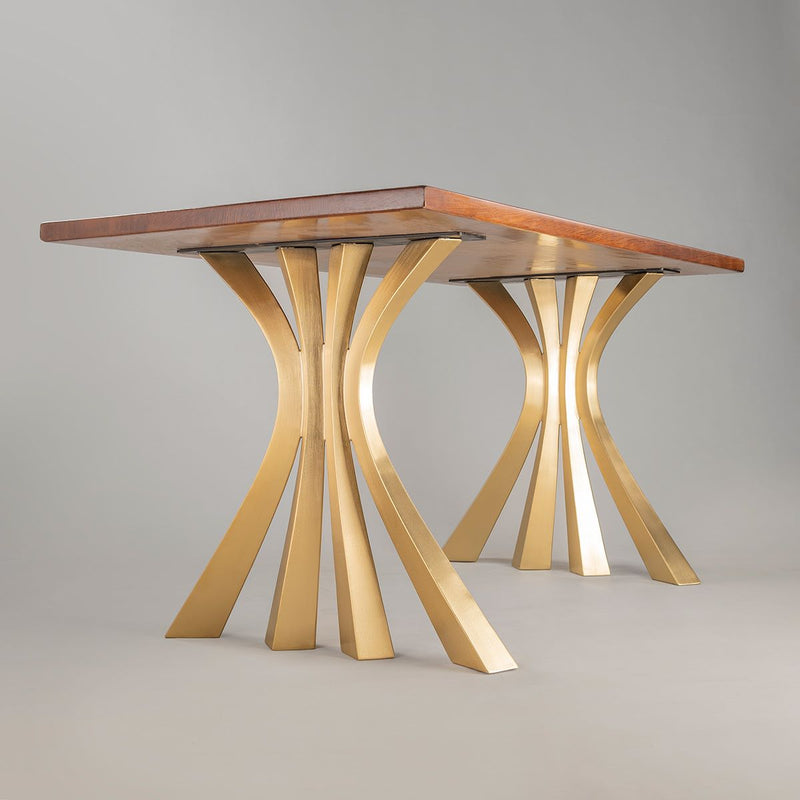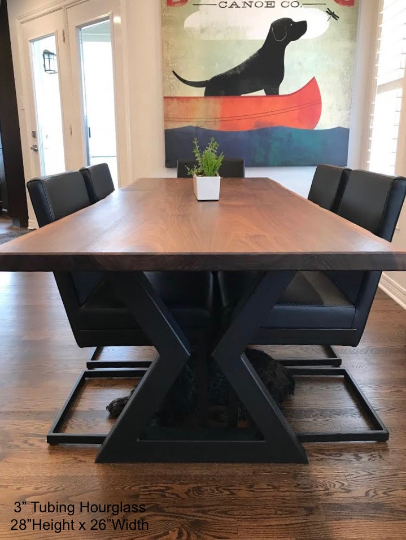Dining Room Table Legs That Integrate Functionality and Modern Design
Dining Room Table Legs That Integrate Functionality and Modern Design
Blog Article
An In-depth Consider Table Leg Styles: Finding the Ideal Suit
Choosing the ideal eating table leg style is crucial for both visual charm and practical functionality. For those with bigger tables, trestle legs make certain strong assistance, whereas hairpin legs introduce a mid-century modern-day vibe with their minimal style. The x-shaped legs mix modern design with improved stability.
Conventional 4 Legs
Among the various types of dining table leg designs, the conventional four-leg style continues to be an ageless selection for numerous houses. 4 legs supply balanced assistance, ensuring the table stays secure and qualified of bearing significant weight (dining room table legs).
From a visual viewpoint, the traditional four-leg design can be easily adapted to various indoor designs. Whether crafted from timber, steel, or a mix of products, these legs can be delicately sculpted, sleek and minimalistic, or anything in between. Their adaptability enables them to enhance both rustic and contemporary settings effortlessly.
Additionally, the uncomplicated structure of the four-leg layout facilitates ease of activity and positioning within a space. Unlike even more facility bases, this design decreases blockages, offering sufficient legroom for diners. In summary, the traditional four-leg table leg design marries withstanding sophistication with useful functionality, making it an astute choice for those seeking both form and function in their eating furnishings.
Pedestal Base
Often celebrated for its stylish and space-efficient layout, the pedestal base is a prominent option to the typical four-leg configuration in eating table leg designs. Without edge legs, diners are managed better liberty of motion, making it an optimal choice for round and oval tables that advertise more intimate and inclusive gatherings.
Furthermore, the pedestal base's central assistance can deal with significant weight, permitting using much heavier table tops, such as marble or thick hardwood. This toughness combined with its visual convenience makes the pedestal base a prominent selection in both conventional and modern interior settings. It can perfectly integrate with various layout motifs, from classic beauty to minimal modernity. Furthermore, the main column itself offers a canvas for elaborate layouts and creative expressions, adding an element of aesthetic rate of interest beneath the table. In summary, the stand base combines performance snappy, making it an improved and functional alternative for varied eating settings.
Trestle Legs
Trestle legs give a robust and ageless foundation for dining tables, characterized by their straight cross-bracing and sturdy assistance beam of lights. Originating from medieval times, this design has advanced yet maintained its essential framework, making it a her explanation seasonal fave in both traditional and contemporary setups. The central trestle beam of light, frequently supported by 2 or even more vertical messages, offers extraordinary security, enabling bigger table sizes without the need for added legs.
A considerable benefit of trestle leg tables is the sufficient legroom they supply. Unlike tables with four corner legs, the lack of blockages at the table's edges provides unblocked space for chairs and diners, boosting convenience and availability. This makes trestle tables optimal for fitting larger events, whether in a dining-room or a reception hall.
The aesthetic versatility of trestle legs is significant. Offered in a variety of materials such as wood, steel, and composite, they can be ended up to match a large range of indoor styles. From rustic farmhouse to sleek modern styles, trestle legs can be customized to suit specific preferences. Their enduring charm and useful benefits make trestle legs an engaging choice for those looking for both style and practicality in their eating table.
Barrette Legs

The allure of barrette legs lies in their simpleness and versatility - dining room table legs. Available in a series of products, consisting of steel and brass, they can be finished in many shades to match various interior styles. Whether coupled with a rustic wooden tabletop or a modern glass surface area, hairpin legs effortlessly blend performance with a touch of vintage appeal
Longevity is another notable feature of hairpin legs. Regardless of their fragile look, these legs are crafted to birth substantial weight, making sure the table remains steady and protected. Additionally, they are reasonably very easy to mount, making them a prominent choice for do it yourself enthusiasts and specialist furnishings makers alike.
X-Shaped Legs

Constructed from materials such as steel, timber, or a combination of both, X-shaped legs can be tailored to match various design choices. Steel legs often offer a sleek and commercial feeling, ideal for loft-style apartment or condos and modern-day dining rooms.
Moreover, the design behind X-shaped legs you could try this out ensures also weight distribution, minimizing the danger of wobbling and boosting durability. This makes them particularly well-suited for larger table that require extra support. Fundamentally, X-shaped legs blend practical design with modern looks, making them a classic option for varied eating environments.
Conclusion
A comprehensive understanding of eating table leg styles reveals the distinct characteristics and advantages of each design. Conventional 4 legs use stability and timeless appeal, while stand bases supply legroom and a streamlined look. Trestle legs guarantee durable support for larger tables, and barrette legs present a mid-century modern visual. X-shaped legs integrate contemporary layout with improved stability. Selecting the ideal leg design ensures both functional and visual complete satisfaction in any eating room.
Report this page